RATING: ♦♦♦♦♦
We spent a couple of warm sunny days walking through Colonial Williamsburg, which is a 301-acre living history museum in the historic district in the modern city of Williamsburg VA. It includes some restored original buildings from the 18th century when the city was the capital of Colonial Virginia, along with reconstructions built mostly in the 1930s through the efforts of Rev Goodwin of Bruton Parish Church along with financial help from John D Rockefeller Jr and his wife Abby.
Colonial Williamsburg is one of the largest history projects in the nation and a major tourist attraction. It is part of the Historic Triangle of Virginia, which includes Jamestown and Yorktown. The three towns are linked by the Colonial Parkway, which is quite scenic, much of it running along the York River.
Colonial Williamsburg is unusual for having been constructed in a somewhat rundown section of a town during the Depression whose then current inhabitants and post-Colonial-era buildings were removed. In their place is a Colonial-era printing shop, a shoemaker’s shop, blacksmith, cabinetmaker, gunsmith, taverns, etc., as well as an impressive Episcopal church, the Capitol building, and the Governor’s Palace. Costumed employees work and dress as people did in that era. Horse-drawn buggies are everywhere.
Surviving colonial structures have been restored as close as possible to their 18th-century appearance. Many of the missing colonial structures were reconstructed on their original sites based on historical documents. The result is quite effective, and we did feel like we were visiting an important colonial city. The effect was heightened somewhat since we had recently visited the home of Thomas Jefferson. He was the last governor of the Colony of Virginia, and was instrumental in moving the capital from Williamsburg to Richmond at the start of the American Revolution.
Back when the restoration project was being planned, the city wisely insisted on maintaining control over the streets and sidewalks in the historic area. So unlike other living history museums, Colonial Williamsburg allows anyone to walk through the historic district free of charge, at any hour of the day.
However, you have to pay for entrance to the shops and museums. We chose to explore for free. Automobiles are restricted from the historic area, but there is free parking in the Visitors Center just a few blocks away with shuttles running back and forth.
Colonial Williamsburg – Williamsburg VA
The first day we went was on the Saturday before Halloween. The weekly Farmer’s Market was in full swing in the Market Square section. It was a great venue with a lot of vendors and live music. We returned a few days later to explore the rest of the historic area. All in all, it was a pleasant way to see the city and take in some history.

